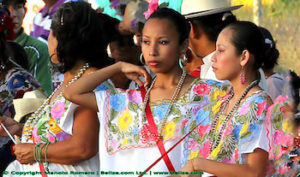
*On this date in 1500, the Mestizo community is briefly mentioned. Mestizo is a term historically used in Spain and Hispanic America, including Hispaniola.
It originally referred to a person of combined European and Indigenous American descent, regardless of where they were born. The term was an ethnic/racial category for mixed-race castas that evolved during the Spanish Empire. Although broadly speaking, mestizo means someone of mixed European/indigenous heritage, the term did not have a fixed meaning in the Middle Passage and colonial period. It was a formal label for individuals in official documentation, such as censuses, parish registers, Inquisition trials, and other matters. Priests and royal officials labeled individuals as mestizos, but the term was also used for self-identification.
The noun mestizaje, derived from the adjective mestizo, is a term for racial mixing used only in the twentieth century; it was not a colonial-era term. It denotes the joyous unity of race mixtures in Latin America in the modern era. This ideological stance contrasts with miscegenation, which usually has negative connotations. In the modern era, particularly in Hispanic America, mestizo has become a cultural term, with Indian being reserved exclusively for people who have maintained a separate indigenous ethnic identity, language, tribal affiliation, etc. In late nineteenth- and early twentieth-century Peru, for instance, mestizaje denoted those peoples with evidence of "mixed" ethno-racial descent and access—usually monetary access, but not always—to secondary educational institutions.
This conception changed by the 1920s, especially after the national advancement and spiritual economy of indigenismo. To avoid confusion with the original usage of the term mestizo, mixed people started to be referred to collectively as castas. In some Latin American countries, such as Mexico, the mestizo concept became central to forming a new independent identity that was neither wholly Spanish nor wholly indigenous. The word mestizo acquired its current meaning, used by the government to refer to all Mexicans who do not speak indigenous languages, including people of complete European or indigenous descent and Asian and Afro Mexicans. During the colonial era of Mexico, "Mestizo" was a category used flexibly to register births in local parishes, although its use did not follow any pattern of strict genealogy.
With Mexican independence, in academic circles created by the "Mestizaje" or "Cosmic Race" ideology, scholars asserted that Mestizos are the result of mixing all races. After the Mexican Revolution, the government, in its attempts to create a unified Mexican identity with no racial distinctions, adopted and actively promoted the "Mestizaje" ideology. The Portuguese cognate, mestiço, historically referred to any mixture of Portuguese, Blacks, and local populations in the Portuguese colonies.
Most of the non-enslaved population in colonial Brazil was initially mestiço de indio, i.e., mixed Portuguese and native Brazilian. There was no descent-based casta system, and children of upper-class Portuguese landlord males and enslaved females enjoyed privileges higher than those given to the lower classes, such as formal education. Such cases were not so common, and the children of enslaved women tended not to be allowed to inherit property.
This right of inheritance was generally given to children of free women, who tended to be legitimate offspring in cases of concubinage (this was a common practice in both Amerindian and African customs). In the Philippines, which was a Captaincy General of Spain, the term mestizo was used to refer to a Filipino with any foreign ancestry and is usually shortened as Tisoy.
In Ontario and western Canada, the Métis are a distinct ethnic community composed of the descendants of Europeans (usually French or Scottish, sometimes English) involved in the fur trade and Canadian First Nations peoples (especially Cree and Anishinaabe. They developed a separate culture of hunters and trappers for generations and were concentrated in the Red River Valley. Métis does not include people of mixed European and Inuit ancestry. As used in Quebec, however, where there was much earlier contact between French and other European colonists and First Nations peoples, the term refers to anyone of mixed ancestry from these two groups.
The United States has a large mestizo population, as many Hispanic Americans of Mexican, Central American, or South American descent are technically mestizo. However, the term "mestizo" is not used for official purposes, with Mexican Americans being classed in roughly equal proportions as "white" or "some other ethnicity," and the term "mestizo" is not in widespread everyday use within the United States. Many Mexican Americans use the term Chicano, which strongly connects with their Native heritage. The date of this article was chosen to align with Cinco de Mayo.